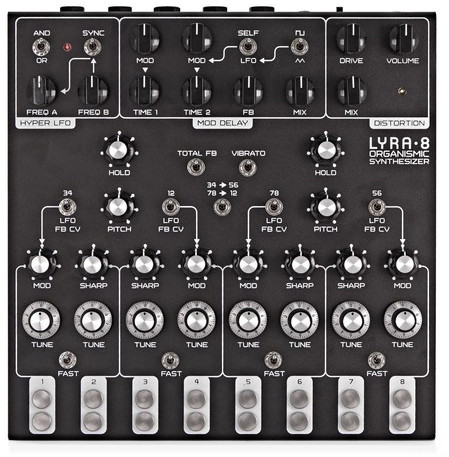
Vultur Cadens (“Falling Vulture”) is an alternate name for the constellation Lyra. It seemed a fitting title for an album featuring the Soma Laboratories Lyra-8 Organismic Synthesizer.
The Lyra-8 is a magnificently strange instrument. Eight independently tuned oscillators based on those in vintage organs, grouped into four pairs and again into two quartets, which can modulate each other in cross-feedback loops and whose response to modulation is not just nonlinear but irrational. They occasionally lock onto each other, often drive each other off course, and occasionally descend into deep subharmonics. These feed a very crusty-sounding twin PT2399 delay and a distortion section, and can be modulated by a “hyper LFO” which produces stuttering patterns. It’s played primarily via skin contact with metal touchplates, as well as subtle knob adjustments and “fast/slow” toggle switches. This is an instrument that prioritizes character and emotion far above predictable behavior or precision — it feels alive, or perhaps haunted.

The Lyra-8 has a very full and dominant sound, and can play all the roles of a full electronic ensemble itself: bass, chords, melodies, drones, rhythms, and noises, simultaneously. But I didn’t want to divide my music into “Lyra” and “non-Lyra” categories, so I made an effort to integrate the instrument with my Eurorack modular and software-based synthesis rig.
Process
Except where noted, all parts on this album were improvised and performed manually. I recorded the Lyra-8 through a Behringer UMC1820 audio interface into Bitwig Studio 3. Where Eurorack processing was involved, it was routed through Expert Sleepers ES-3 and ES-6 modules. Recordings were done in one take to a stereo mix, without overdubbing or multitracking. Additional processing was applied during an editing phase, in Bitwig and/or Sound Forge Pro 13.
Tracks 4 (“Vultur Cadens”) and 6 (“Crawling on the Face”) were mastered by Nathan Moody at Obsidian Sound. The highly valuable feedback from that process gave me the boost I needed to master the other tracks myself. (Thanks to fellow Lyra-8 player j bowman for suggesting that course of action.)
The following tools were used throughout the album during recording, editing and mastering: HASound MSLR, Izotope RX6 DeClick, Native Instruments Solid Bus Comp & Supercharger GT, Klanghelm MJUC, Toneboosters Barricade 4 & Equalizer 4, Wavesfactory Cassette, Voxengo Correlometer & SPAN, u-he Presswerk & Uhbik-Q, and Youlean Loudness Meter.
01 Variable Density
This is the Lyra-8 injecting its audio — mostly the delay section feeding back until it resonates — into a modular cross-feedback loop consisting of two Mutable Instruments Rings resonators and a Make Noise Mimeophon delay. In addition to manual control, six independent LFOs from Mutable Instruments Stages automate the resonator and delay parameters.
02 Cauldron
The Lyra-8, with its delay modulated by an LFO from The Harvestman Kermit. It’s processed through ReaFIR to reduce some of the noise, and Make Noise Mimeophon for an additional layer of delay. The “bumps” in the bass range run though Valhalla Plate to exaggerate their size, while there’s subtle stereo autopanning in the high frequency range.
03 Shell
I set the Mimeophon to infinite repeats so that it built up noise in its buffer, and used that as an input to Rings. Rings went to two places: through Denise Bad Tape and u-he Twangstrom, and into the Lyra’s audio input.
The Lyra was processed by Bitwig’s pitch shifter, Valhalla Delay and Valhalla Vintage Verb.
A background voice was provided by IME Hertz Donut mk3, through Mutable Instruments Ripples and Joranalogue Filter 8, modulated by Synthesis Technology E352 and Kermit, sequenced by Mutable Instruments Marbles, through Valhalla Plate.
The full mix was processed by Ratshack Reverb (which despite the name, is an emulated bucket brigade delay).
04 Vultur Cadens
This is just the Lyra-8 with a little adaptive noise reduction (believe it or not!) from Klevgrand Brusfri, plus Arturia Delay Eternity and Valhalla Vintage Verb.
05 Bitter Brew
Here I fed the Lyra-8 a pitch sequence from the Korg SQ-1, rhythmically clocked by Marbles. There’s an extremely complex, difficult to predict relationship between input voltage and oscillator pitch, which varied between different oscillators. I tuned my sequence to produce a melody line that I liked on a couple of the oscillators, and let the rest act as they would as I played the touchplates.
Processed with Bitwig’s Delay-2 with XLNAudio RC-20 Retro Color in its feedback path, Melda MCharacter, Valhalla Plate, u-he Runciter and Sequoia DeHisser.
06 Crawling on the Face
This is mainly the Lyra’s delay modulated by its hyper LFO, with occasional blasts from its oscillators. It’s processed through a feedback loop with AudioThing FogConvolver and Bitwig’s peak limiter, and then Valhalla Delay and u-he Twangstrom. A drone from the Yamaha Reface CS through Elektron Analog Drive, Bitwig’s frequency shifter, and Valhalla Plate.
07 Ergot
The Lyra-8 is processed through Bitwig Grid’s Chebyshev waveshaper, Grayscale Supercell, Make Noise Mimeophon, Denise Bad Tape, d16 Decimort, Valhalla Plate and XLNAudio RC-20. Several effect parameters are controlled from an Expressive-E Touché SE.
08 Earth Tone
This is the Lyra-8 through my own Horse glitch chorus plugin, Valhalla Vintage Verb and Valhalla Delay. The recording was then timestretched with three different methods, blended to create the rhythmic pulses.
09 Luminous
This is the Yamaha Reface CS through Elektron Analog Drive, Valhalla Plate, and Unfiltered Audio SpecOps. The result is fed through the Lyra-8’s audio input to add delay and light distortion as well as the drone part, and then u-he Twangstrom, Arturia Delay Tape-201 and Klevgrand Haaze. The Reface part is the only MIDI sequence on this album.
10 Flagellum
The initial recording consists of three main parts:
- A cymbal sample granularized in Bitwig Sampler, through Rabid Elephant Natural Gate and Valhalla Plate.
- A drone consisting of SynthTech E352 and Hertz Donut mk3 cross-modulating each other, with shifting balance betwen them.
- The Lyra-8, through XLNAudio RC-20.
The full mix was then processed through Natural Gate and Mimeophon, clocked by a rhythmic pattern from Monome Teletype.
